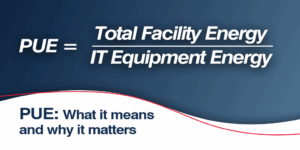Power Usage Effectiveness: What It Means and Why It Matters
 Power Usage Effectiveness (PUE) is a fundamental metric for measuring how efficiently a data center consumes energy – especially crucial in today’s cloud-first, energy-conscious IT landscape.
Power Usage Effectiveness (PUE) is a fundamental metric for measuring how efficiently a data center consumes energy – especially crucial in today’s cloud-first, energy-conscious IT landscape.
At its core, PUE is the ratio of a data center’s total energy consumption to the energy consumed by its IT equipment:
PUE = Total facility energy / IT equipment energy
A PUE of 1.0 represents the ideal – where every watt of energy supports computing, with none lost to cooling, lighting, or overhead. In the real world though, data centers require additional power to keep servers at optimal conditions, pushing PUE above 1.0.
What does PUE measure?
PUE quantifies how much of a facility’s energy goes directly into IT equipment, such as servers, storage, and network equipment, versus supporting systems. For example, if a facility uses 1,500 kWh in total and 1,000 kWh is used by IT hardware:
PUE = 1500 / 1000 = 1.5
That means only two-thirds of the energy supports computing. The rest likely goes to cooling, ventilation, or backup systems.
Why PUE is so important
- Operational efficiency: PUE provides clear insight into how well a facility manages energy use.
- Cost control: A lower PUE = lower operating expenses tied to non-IT power use.
- Environmental responsibility: Higher efficiency leads to a reduced carbon footprint.
While it’s not a perfect measurement, in that it doesn’t account for energy reuse or climate-based variations, PUE remains a widely embraced standard.
The practical realities of measuring PUE
Despite its clear-cut formula, calculating PUE isn’t always simple. It is rarely a one-off measurement – monitoring PUE over time paints a better picture of efficiency trends. Comparing PUE across different facilities is also tricky – even data centers of similar size may vary drastically due to differences in location, weather, utility infrastructure, and building design. Definitions of what counts as “IT load” versus “infrastructure load” can also vary amongst businesses, complicating consistent reporting.
Additional challenges include:
- Some infrastructure elements may exist in one facility but not another.
- Shared systems (e.g. chillers used by both office and data center spaces) can muddy the numbers.
- Measuring fine-grained subsystems like PDUs can be expensive and technically difficult.
- Power meters may capture energy not exclusively used by the data center.
Tips for calculating PUE accurately
To get more precise readings, facility energy should be measured near the utility meter – and only for the portion powering the data center. IT energy is best measured after power has been converted and conditioned, typically at the power distribution units (PDUs) feeding the server racks.
In mixed-use buildings, estimates may be necessary to subtract non–data center usage from total energy figures.
How to reduce PUE
- Improving PUE is a win-win – it saves money and boosts environmental credentials. Practical steps to achieving low PUE are:
- Optimized cooling: Better airflow management, refined cold aisle containment, smarter layouts, and high-efficiency cooling systems can yield significant savings.
- Small tweaks, big gains: Use energy-efficient power supplies, automate lighting, and eliminate waste wherever possible.
- Track and iterate: Regularly monitor PUE to identify inefficiencies early and benchmark progress over time.
- System design and modelling: Engaging in early modelling during building and system design ensures the facility starts on the right foot. Continuing to use this throughout the building lifecycle to understand what changes are required can have the biggest impact and is also critical to ongoing best practice.
Beyond PUE: other metrics to know
While PUE leads the charge, a broader sustainability picture emerges when we consider additional metrics that delve deeper into environmental impact and, in some cases, even the performance of the IT equipment itself.
- WUE (water usage effectiveness): measures total water consumption. Particularly critical when evaporative cooling systems are applied.
- ERF (energy reuse factor): Highlights the extent to which expelled heat or energy is repurposed for other uses – for example, heating nearby buildings.
- CUE (carbon usage effectiveness): Reflects the carbon emissions associated with energy consumed by IT systems.
- REF (renewable energy factor): Gauges how much of the energy powering the data center comes from renewable sources; a vital consideration for operators looking to lower their carbon intensity.
By understanding and optimizing PUE, and integrating these measurements alongside other metrics, data centers can make informed decisions, boost sustainability, and stay competitive in an increasingly resource-conscious digital era.
Visit our sustainability pages to learn more about our approach to sustainability, or for more information please feel free to contact us.





